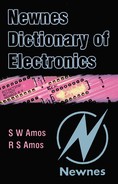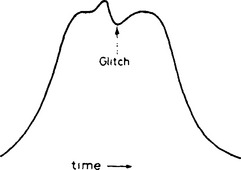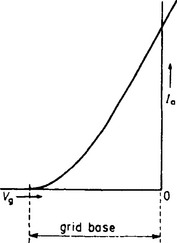G
gain In general an indication of the extent to which the amplitude of a signal is increased by its passage through an electronic system or part of it. More specifically the ratio of the output-signal power, voltage or current to the input-signal power, voltage or current. The ratio is usually expressed in decibels as
gain-bandwidth product Of an active device a figure of merit assessing its usefulness as a wideband amplifier. A given active device can give a particular value of gain over a particular value of bandwidth and if the bandwidth is changed the gain is changed in the inverse ratio so that the product remains constant. For an electron tube the gain-bandwidth product is proportional to gm/(Cin + Cout), where gm is the mutual conductance, Cin the input capacitance and Cout the output capacitance. Thus for wideband applications, tubes with high mutual conductance and low input and output capacitances should be chosen.
gallium arsenide (GaAs) A semiconductor material in which the electron mobility is better than that of silicon. This makes the material suitable for use in microwave transistors (MESFETs) and for high-speed operations in computers. GaAs also has the property that the electrons can exist in two states as described under Gunn effect. GaAs is also used in LEDs.
galvanometer An instrument for the detection and measurement of very small electric currents. In one type the current passes through a rotatable coil situated in the field of a permanent magnet. The resultant magnetic interaction causes the coil to rotate against the restoring force of a spring, so moving a pointer or a small mirror which reflects a narrow beam of light across a scale.
gamma (γ) In TV a factor expressing the relationship between the contrast in the reproduced image and that in the original scene. Quantitatively it is the slope of the curve of output luminance plotted against input luminance, both being plotted on logarithmic scales. As shown in Figure G.1 the overall gamma is given by the slope of the chord connecting two points P and Q which define the length of the characteristic used in the system. Thus overall gamma is given by
where R1 and R2 are the luminances of the two points in the reproduced image and S1 and S2 are the luminances of the corresponding points in the original scene.
For a colour TV system the overall gamma should be unity but for black-and-white television where the contrast due to colours is absent an overall gamma of slightly greater than unity, say, 1.2, is recommended.
Because of the curvature of the characteristic the gamma as measured by the slope of the curve can differ appreciably from the overall value. Thus point gamma or contrast gradient at a given point in the characteristic is measured by the slope of the tangent to the point and it is useful to know its value because it measures the visibility of detail in tonal values in the image corresponding to the point. For example in Figure G.1 the tangent AB measures the point gamma in low-light areas of the image and clearly this gamma is less than the overall gamma, suggested that perhaps some ‘black stretching’ may be desirable.
gamma rays Electromagnetic waves similar to X-rays and of approximately the same frequency emitted from radioactive atoms during disintegration.
ganging Simultaneous adjustment of two or more circuits by a common mechanical control. In a stereo amplifier, for example, operation of the gain control simultaneously adjusts the gain in both channels. In a superheterodyne receiver tuning of the oscillator and RF circuits is simultaneously adjusted by a single control.
gas amplification factor Of a gas-filled photocell the ratio of the sensitivity with and without ionisation of the gas.
gas current In a vacuum tube the flow of positively-charged ions to a negatively-charged electrode. The ions are produced by ionisation of residual gas by the electron current of the valve.
gas discharge The conduction of a current between two cold electrodes in an ionised gas tube when the potential difference between them is made sufficiently high.
gas-filled rectifier A gas-filled tube used as a rectifier. The term is a general one which embraces tubes with a mercury-pool cathode or an indirectly-heated cathode; the anode current may or may not be controlled by a third electrode.
gas-filled tube A tube of which the electrical properties are dependent upon the ionisation of gas deliberately included in the envelope.
gas-filled valve Same as gas-filled tube.
gas focusing In a cathode ray tube focusing of the electron beam by allowing a trace of gas to remain in the envelope. The electron beam ionises the gas and the positive ions so released set up a field which counteracts the mutual repulsion between the beam electrons and concentrates the beam into a convergent form.
gas tube Same as gas-filled tube.
gate (semiconductor) In a field-effect transistor the electrode to which the signal voltage is applied to control the effective width and thus the resistance of the channel. In a thyristor the electrode to which the control signal is applied to switch the device to the on-state (and in some devices to the off-state).
gate array See Application Specific Integrated Circuit.
gated-beam tube A pentode designed to operate as a self-limiting phase-difference discriminator in FM receivers, the input signals from the primary and secondary windings of the IF transformer being applied to the control grid and suppressor grid. The tube operates in the same manner as a nonode and the electrodes are laid out in a manner quite dissimilar to those of a conventional pentode in order to achieve the type of limiting action required at the grids.
gate turn-off switch A semiconductor device combining the voltage- and current-carrying capacities of the thyristor with the control of the transistor. It is a four-layer device which can be switched on and off by signals applied to the gate.
Gaussian distribution For a quantity which varies statistically about a mean value the shape of the curve which shows, for any chosen value, the probability of a sample having that value. If a very large number of observations of the quantity are taken and if, for a number of discrete values, the number of observations having each value are plotted, a curve of the shape of Figure G.2 is obtained.
This is often known as a probability curve and it shows that the number of observations having a value markedly different from the mean value is very small but that the number increases as the value selected approaches the mean value.
Geiger-Muller tube Electron tube used for the detection of alpha or beta particles or gamma rays. The tube consists of a fine wire anode surrounded by a co-axial cold-cathode cylinder, the intervening space being filled by gas at a low pressure. The voltage between anode and cathode is adjusted to just below the ionising potential of the gas. When any of the radiations to be detected enters the tube it causes momentary ionisation of the gas so that a pulse of current flows through the tube. These pulses are usually transferred to a counter circuit to form a Geiger counter equipment.
geometric distortion In television any displacement of picture elements in a reproduced image from the correct positions, i.e. those of the corresponding elements in the original scene.
Germanium (Ge) A tetravalent crystalline element (atomic number 32) widely used in the manufacture of semiconductor devices. In its pure state the element is an insulator but by suitable doping p- or n-type conductivity of a value suitable for semiconductor devices can be obtained. Germanium devices have a significant leakage current at normal temperatures making them liable to thermal runaway and have to a large extent been superseded by silicon devices.
getter A material included in a vacuum tube to remove traces of gas remaining after pumping and sealing or which may be released when the tube is put into use. The most commonly-used getter is barium and after the tube is sealed a pellet of the material is vapourised by eddy-current heating and condenses on the walls, combining with the remaining gas as it does so.
glitch Distortion of a pulse waveform in the form of a short-duration disturbance. A typical example is shown in Figure G.3.
glow discharge In a gas-filled tube with a cold cathode, conduction as a result of electronic emission caused by bombardment of the cathode by positive ions. There is usually weak emission of light.
Gouriet oscillator Same as Clapp oscillator.
graded-base transistor A bipolar transistor in which the impurity concentration in the base region increases smoothly between the collector and emitter junctions.
Such a graded concentration, which can be produced by diffusion, gives an electric field which speeds up the passage of charge carriers across the base region, so reducing transit time and improving high-frequency performance.
gramophone Dated term for a disk player.
graphic equaliser An audio equaliser in which the audio spectrum is divided up into a number of contiguous bands which are individually amplified, adjustment of the gain controls permitting any desired shape of frequency response to be obtained. The frequency bands may be one octave or one third octave in bandwidth and the gain controls are usually slider types so arranged that a level frequency response is obtained when the controls are in line. When the sliders are moved, their positions give an indication of the shape of the frequency response of the equaliser.
graphical user interface (GUI) A user interface for a computer system in which most routine operations are performed graphically, i.e. using a mouse or other pointing device to move a pointer on to icons on the screen instead of typing textual commands. For example, to copy a file from one directory to another typically involves displaying windows representing the source and destination directories, selecting the icon in the source directory that represents the file to be copied and dragging this into the destination directory.
graphics In computing, matter appearing on a VDU or in a printout apart from text in the computer’s or printer’s regular typeface (font). Usually such graphics consist of pictures, diagrams or rules, boxes, borders or other embellishments. There are two principal systems for creating and editing graphics using a computer.
In bitmap graphics (also called raster graphics) images are stored as a two-dimensional array of pixels. Examples include the output from scanners and video digitisers. Applications for creating and editing bitmaps are sometimes called painting software, since ultimately they are concerned only with the colours of areas of pixels. Such applications often feature sophisticated tools for creating lines and shapes in a selected colour and for image processing, that is, subjecting the whole or part of the image to some change of colours or dimensions.
The alternative system is vector graphics, in which the image is stored effectively as a sequence of co-ordinate-based data describing the lines and shapes of which the image is composed. Applications for creating and editing vector graphics are sometimes called drawing software, since it is essentially line-based. Advantages of vector graphics are that the stored image is independent of the output device, it is easy to edit and scale and it may have more than two dimensions. Three-dimensional drawing packages are widely used, for example to create the mathematical models that form the basis of virtual reality. Even two-dimensional packages may divide a drawing into a number of superimposed layers which can be turned on and off individually to show different aspects of the subject, such as the various utilities in a map of a city. Computer-aided design packages are usually vector-based.
In computers that use a graphical user interface, however, it is common practice for text to be reproduced on the screen or in printouts in industry-standard typefaces (fonts) that have been stored in the computer as vector graphic images (see outline fonts) and are subsequently rendered using graphical routines rather than textual routines.
graphics accelerator An expansion card that accelerates a computer’s handling of graphics on the screen. Some accelerators provide a separate microprocessor dedicated to handling screen output, freeing the main processor for the application task. Others use a variety of techniques to circumvent the more processor-intensive aspects of writing to the screen.
Graphics Interface Format (GIF) A bitmap file standard originally developed for use in bulletin board systems. It incorporates LZW compression, substantially reducing most file sizes and therefore also the time taken to transmit the image over costly leased lines. Its disadvantage is its limitation of 8 bits per pixel and it is now being superseded to some extent by JPEG which offers 24 bits per pixel and even higher compression factors.
Gray code A binary code in which the codes for any two consecutive numbers differ by only one binary digit.
grid An electrode located between the cathode and the anode of an electron
tube and through the interstices of which the main electron stream of the tube passes.
A tube may have a number of grids (e.g. a pentode has three) and each usually has the form of a wire spiral surrounding the cathode, the electron stream passing through the meshes of the spiral. The pitch of the spiral is chosen to give the required degree of control over the density of the electron stream.
grid base Of an electron tube the range of grid voltage between zero and that which gives cut off of anode current. This is illustrated in Figure G.4. The grid base depends on the value of anode and screen-grid voltages and these should be stated when values of grid base are quoted. The value of the grid base gives an indication of the maximum peak-to-peak signal input voltage the tube can accept under class-A conditions.
grid bias (GB) Of an electron tube the steady voltage applied to the control grid to ensure that signal excursions operate over the required region of the characteristic. The value of the grid bias depends on the anode and screen-grid voltages and these should be stated when values of grid bias are quoted. In class-A operation the grid bias voltage is chosen to give an operating point near the centre of the most linear part of the characteristic.
grid characteristic Of an electron tube the relationship between grid voltage and grid current exhibited graphically.
grid emission Of an electron tube the emission of electrons or ions from the grid. This can arise as a result of heating of the grid (primary grid emission) or of bombarding it by electrons or ions (secondary grid emission).
grid leak Dated term for a resistor, usually of high value, connected to the control grid of an electron tube and used to apply grid bias.
grid-leak detector An AM detector in which the control grid and cathode of a triode or multi-grid electron tube operate as a diode detector, the AF output being amplified by the tube.
One possible circuit for a grid-leak detector is given in Figure G.5. The output of the diode detector is the voltage generated across C1 and this provides the tube with grid bias and also with the AF input signal. Clearly only for one particular value of input signal will the direct component across C1 be the optimum value of grid bias. In general, therefore, the detector gives considerable harmonic distortion but with the aid of reaction it can be made very sensitive and it was very popular in the early days of radio.
grid stopper See parasitic stopper.
grounded-anode, -base, -emitter, -grid, etc circuit Literally a circuit in which the anode, base, emitter grid, etc is earthed but the term is generally used to mean a common-anode, common-base, common-emitter, common-grid circuit, etc.
ground loop Same as earth loop.
ground return Same as earth return.
group code An error-detecting code used to verify correct transmission of a group of characters.
group delay Same as envelope delay.
group velocity Same as envelope velocity.
grown transistor An early method of manufacturing bipolar transistors by ‘pulling’ a crystal from the molten semiconductor material, the required p- and n-regions being formed in the crystal by introducing pellets of appropriate impurity into the molten material as the crystal is withdrawn.
guard band A frequency band between neighbouring channels which is left vacant to give a margin of safety against mutual interference.
Gunn effect The splitting of charge carriers into domains by a steady electric field. In certain semiconductors, typically gallium arsenide, electrons can exist in a high-mass low-velocity state as well as their normal low-mass high-velocity state and they can be forced into the high-mass state by a steady electric field of sufficient strength. In this state they form clusters or domains which cross the field at a constant rate so that current flows in a series of pulses. This can be made the basis of a microwave oscillator. See Gunn-effect diode.
Gunn-effect diode A semiconductor device used as a microwave oscillator. It is not, strictly speaking, a diode, consisting of an epitaxial layer of n-type gallium arsenide grown on a GaAs substrate. Ohmic contacts are made to the substrate (anode) and the n-layer (cathode). A potential of a few volts between anode and cathode produces an electric field causing electrons to cross the device in clusters or domains (see Gunn effect). Thus the current is in the form of pulses with a frequency dependent on the transit time and hence on the thickness of the n-layer. In use the device is mounted in a cavity resonator and powers up to 1 W at frequencies between 10 and 30 GHz are possible. Certain other semiconductor materials can also be used in Gunn-effect diodes.





